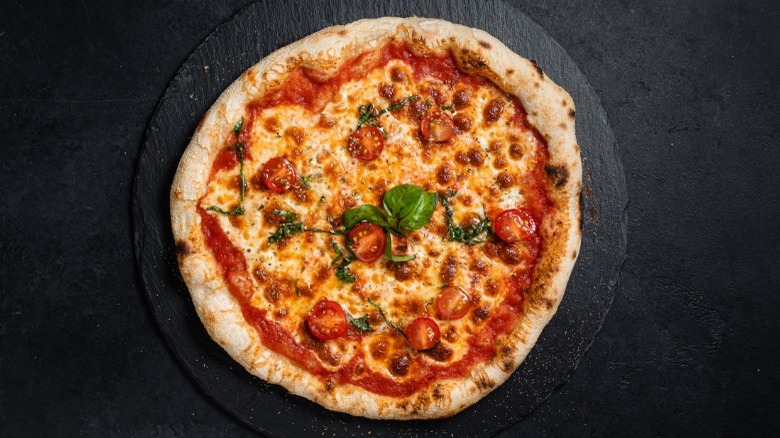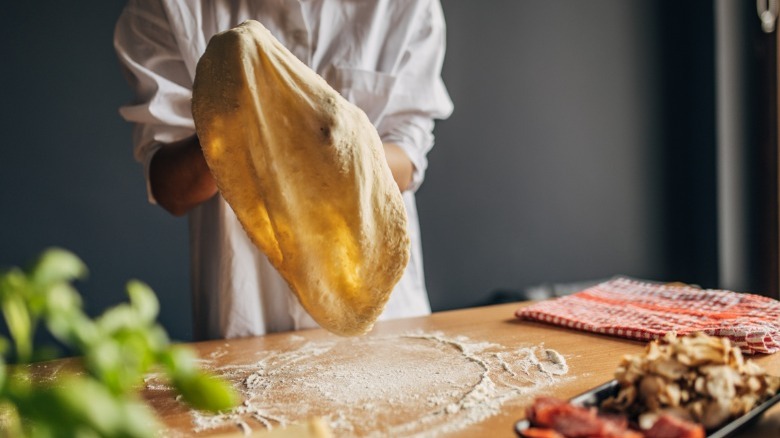Giada De Laurentiis' Tip For Better Pizza Crust Is Actually Ice
Giada De Laurentiis is an Italian food expert, but there are some cooking tips that still surprise even her. One tip that the chef recently discovered on a trip to Italy involves adding ice on top of pizza dough before it goes into the oven. De Laurentiis picked the tip up from Stefano Callegari, a chef in Rome, who uses it to create a starchy pasta water-esque liquid in the center of his cacio e pepe pizza.
Your classic cacio e pepe makes use of starchy pasta water to thicken its sauce, and the same method is employed by Callegari on his pizza. Once the dough is cooked and the layer of dough-water forms, it gets sprinkled with Pecorino cheese, which combines with the water to create that delicious cheesy cacio e pepe sauce that we know and love. According to Callegari, the method allows for a crunchy crust, a gooey middle, and a sandy top.
Get creative! Add shallot — the magic ingredient for perfect cacio e pepe — for another layer of flavor on top of that crust. Besides being key if you want to replicate cacio e pepe sauce on a pizza, adding ice to or on top of pizza dough has other useful applications as well.
Is ice and pizza dough a common trick?
While this might seem like an out-there tip, it's not unheard of in the realm of pizza (and even bread) baking. If you're not looking to make a cacio e pepe pizza, the ice cubes actually have other benefits. For one, they'll weigh down the dough while it's baking, which stops large air bubbles from forming. This is important when you're baking a bald pizza — so you can add toppings afterward. You want the center of your dough to be nice and flat, so whatever toppings you add sit smoothly and evenly on the crust. Additionally, the melted ice will stop the center of the dough from being too crispy and brown before the thicker edges of the crust can fully cook.
Keeping dough cool is also essential to delay the yeast rising prematurely — or dying from too much heat in a mixer. To ensure you get a nice, fluffy crust, a bit of crushed ice can help control the temperature of your dough.
If you're using ice during the mixing process instead of putting it on top before baking, the type you employ matters more than you may think. Cube and tube-shaped ice have larger surface areas than chipped or crushed ice. This means that they will take longer to melt, not allowing enough time for the water to be incorporated into the dough as it gets mixed.
Other ways to improve your pizza dough
Making pizza dough is an art form, but there are a number of ways you can make it easier. One of Giada De Laurentiis' secrets to getting the best pizza dough is adding some honey to your yeast and warm water mixture — yeast loves sugar, so honey is the ideal addition and gives a more golden crust than plain sugar. The chef also says to make sure that your yeast is bubbling and alive, and if not, get fresh because your dough won't rise.
Additionally, the type of flour you use matters a lot when making pizza dough. If you want a chewier crust, use bread flour instead of white flour. To try and replicate what they do in Italy, get your hands on some 00 Italian flour made specifically for pizza.
Pizza chains have fun garlic-flavored crusts, and you could do the same when making dough at home. Adding additional spices like garlic powder or an Italian seasoning blend to your dough will give it that extra bite of flavor and set it apart from unseasoned dough. Another good addition that'll help you achieve a perfectly crispy crust is cornmeal. Dust your pizza pan with cornmeal before laying down the dough, and the final pie will be just as satisfying as one delivered to your door.



